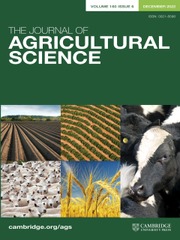Crossref Citations
This article has been cited by the following publications. This list is generated based on data provided by
Crossref.
Gasim, Seif
Abel, Stefan
and
Link, Wolfgang
2004.
Extent, variation and breeding impact of natural cross-fertilization in German winter faba beans using hilum colour as marker.
Euphytica,
Vol. 136,
Issue. 2,
p.
193.
Suso, M. J.
Harder, Lawrence
Moreno, M. T.
and
Maalouf, Fouad
2005.
New strategies for increasing heterozygosity in crops: Vicia faba mating system as a study case.
Euphytica,
Vol. 143,
Issue. 1-2,
p.
51.
Toker, Cengiz
Canci, H.
and
Ceylan, F. O.
2006.
Estimation of Outcrossing Rate in Chickpea (Cicer Arietinum L.) Sown in Autumn.
Euphytica,
Vol. 151,
Issue. 2,
p.
201.
Benachour, Karima
Louadi, Kamel
and
Terzo, Michaël
2007.
Rôle des abeilles sauvages et domestiques (Hymenoptera : Apoidea) dans la pollinisation de la fève (Vicia fabaL. var.major) (Fabaceae) en région de Constantine (Algérie).
Annales de la Société entomologique de France (N.S.),
Vol. 43,
Issue. 2,
p.
213.
Suso, M.J.
Nadal, S.
Roman, B.
and
Gilsanz, S.
2008.
Vicia faba germplasm multiplication – floral traits associated with pollen‐mediated gene flow under diverse between‐plot isolation strategies.
Annals of Applied Biology,
Vol. 152,
Issue. 2,
p.
201.
Terzopoulos, P.J.
Kaltsikes, P.J.
and
Bebeli, P.J.
2008.
Determining the sources of heterogeneity in Greek faba bean local populations.
Field Crops Research,
Vol. 105,
Issue. 1-2,
p.
124.
Palmer, Reid G.
Perez, Paola T.
Ortiz-Perez, Evelyn
Maalouf, Fouad
and
Suso, María José
2009.
The role of crop-pollinator relationships in breeding for pollinator-friendly legumes: from a breeding perspective.
Euphytica,
Vol. 170,
Issue. 1-2,
p.
35.
Patrick, J.W.
and
Stoddard, F.L.
2010.
Physiology of flowering and grain filling in faba bean.
Field Crops Research,
Vol. 115,
Issue. 3,
p.
234.
Kwon, Soon-Jae
Hu, Jinguo
and
Coyne, Clarice J.
2010.
Genetic diversity and relationship among faba bean (Vicia faba L.) germplasm entries as revealed by TRAP markers.
Plant Genetic Resources,
Vol. 8,
Issue. 3,
p.
204.
Suso, María José
and
Maalouf, Fouad
2010.
Direct and correlated responses to upward and downward selection for outcrossing in Vicia faba.
Field Crops Research,
Vol. 116,
Issue. 1-2,
p.
116.
Alghamdi, Salem
Al-Faifi, Sulieman
Migdadi, Hussein
Khan, Muhammad
EL-Harty, Ehab
and
Ammar, Megahed
2012.
Molecular Diversity Assessment Using Sequence Related Amplified Polymorphism (SRAP) Markers in Vicia faba L..
International Journal of Molecular Sciences,
Vol. 13,
Issue. 12,
p.
16457.
Benachour, K.
and
Louadi, K.
2013.
Inventory of Insect Visitors, Foraging Behaviour and Pollination Efficiency of Honeybees (Apis melliferaL.) (Hymenpoptera: Apidae) on Plum (Prunus salicinaLindl.) (Rosaceae) in the Constantine Area, Algeria.
African Entomology,
Vol. 21,
Issue. 2,
p.
354.
Soengas, P.
Velasco, P.
Vilar, M.
and
Cartea, M. E.
2013.
Mating System of Brassica napus and Its Relationship with Morphological and Ecological Parameters in Northwestern Spain.
Journal of Heredity,
Vol. 104,
Issue. 4,
p.
491.
Fouad, Maalouf
Mohammed, Nawar
Aladdin, Hamwieh
Ahmed, Amri
Xuxiao, Zong
Shiying, Bao
and
Tao, Yang
2013.
Genetic and Genomic Resources of Grain Legume Improvement.
p.
113.
Suso, M. J.
and
del Río, R.
2014.
Faba bean gene-pools development for low-input agriculture: understanding early stages of natural selection.
Euphytica,
Vol. 196,
Issue. 1,
p.
77.
González, Ana M.
De Ron, Antonio M.
Lores, María
and
Santalla, Marta
2014.
Effect of the inbreeding depression in progeny fitness of runner bean (Phaseolus coccineus L.) and it is implications for breeding.
Euphytica,
Vol. 200,
Issue. 3,
p.
413.
Suso, María José
Bebeli, Penelope J.
and
Palmer, Reid G.
2015.
Grain Legumes.
Vol. 10,
Issue. ,
p.
365.
Smýkal, Petr
Coyne, Clarice J.
Ambrose, Mike J.
Maxted, Nigel
Schaefer, Hanno
Blair, Matthew W.
Berger, Jens
Greene, Stephanie L.
Nelson, Matthew N.
Besharat, Naghmeh
Vymyslický, Tomáš
Toker, Cengiz
Saxena, Rachit K.
Roorkiwal, Manish
Pandey, Manish K.
Hu, Jinguo
Li, Ying H.
Wang, Li X.
Guo, Yong
Qiu, Li J.
Redden, Robert J.
and
Varshney, Rajeev K.
2015.
Legume Crops Phylogeny and Genetic Diversity for Science and Breeding.
Critical Reviews in Plant Sciences,
Vol. 34,
Issue. 1-3,
p.
43.
Suso, M. J.
and
del Río, Rosario
2015.
A crop–pollinator inter-play approach to assessing seed production patterns in faba bean under two pollination environments.
Euphytica,
Vol. 201,
Issue. 2,
p.
231.
Bishop, Jacob
Jones, Hannah Elizabeth
Lukac, Martin
and
Potts, Simon Geoffrey
2016.
Insect pollination reduces yield loss following heat stress in faba bean (Vicia faba L.).
Agriculture, Ecosystems & Environment,
Vol. 220,
Issue. ,
p.
89.

